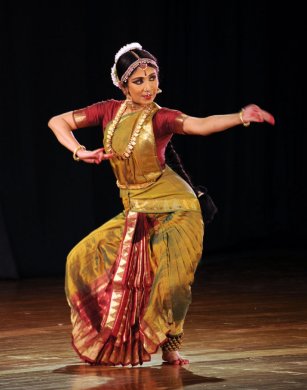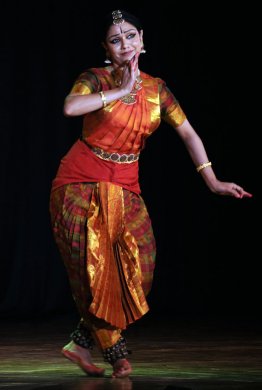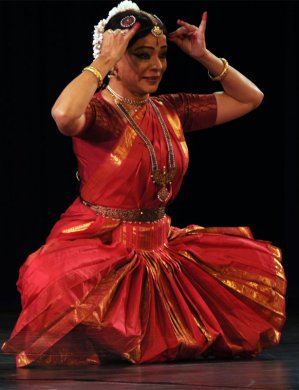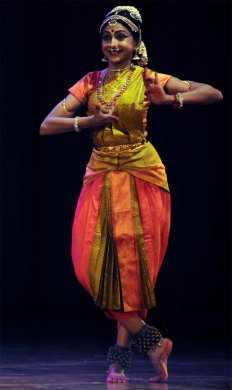
|   |

|   |
Madras Music Academy Annual Dance Festival 2015: A few simmering stars by sunset - Veejay Sai e-mail: vs.veejaysai@gmail.com Photos: Thanthoni January 25, 2015 The Academy's main slots, the coveted 6pm slots had an odd mix and match this year. These slots are meant to showcase the crème-de-la-crème of Indian classical dancers in the whole festival. On the second evening the Academy saw what probably was the largest crowd any show drew for the dance festival. Rasikas thronged to witness the jugalbandi between Alarmel Valli and Carnatic vocalist Bombay Jayashri as a tribute to commemorate the centenary celebrations of T. Mukta. Where I was seated had a mix of rasikas asking each other if they had come for Valli or for Jayashri. The Jayashri fans even got annoyed and expressed a slight disappointment when they didn't find Jayashri seated in the orchestra as Valli opened her performance. Valli started with a pada varnam Kaana Aavalaanen Eeshanai in praise of lord Shiva composed by her long time collaborator Prema Ramamurthy. The heroine expresses her love for Shiva and imagines him as Neelakantha in the darkness of rain clouds. As spring season arrives, she is inspired to a divine ecstasy. In a fine balance between depicting an imagery of nature and the relation to a heroine's longing, Valli's performance shone, like most often it does. Nandini Anand's singing, which otherwise fits well was replete with fatigue as she barely managed to reach the upper scale. Wonder why has she reduced her range of singing over the years from a decent standard to two kattais less? Is over-working softly killing her voice? Or is it season-end fatigue? J.B. Sruthi Sagar's melodious flute kept the pace going for the piece. In the second half of the performance, the excitement in the hall increased as Bombay Jayashri joined the orchestra. Presenting the famous Javali Jaanaro ee mohamu sahimpaga lene ascribed to Ramanathapuram Srinivasa Iyengar, Jayashri set the mood of ragam Khamas. In celebration of love the nayika longs for lord Venkateshwara. Jayashri's voice might be melodious for regular Carnatic kutcheris but her pronunciation of sahityam fell flat here. She kept singing 'Muddu Gomma' instead of 'Gumma', changing the meaning. When you don't understand how language, meter, syntax and grammar are highly integral to the presentation of any composition, you tend to ruin it unconsciously. That's why it is not easy to compose poetry in Indian languages. Most new-age composers assume compiling a bunch of rhyming god's names into a tune amounts to a composition. In the following presentation of Kshetrayya's famous Nadanamakriya padam Paiyyada, once again Jayashri kept singing 'Ammammo' instead of 'Ayyayyo'. It should have been made clear to the audience that she chose to sing the Dhanammal school version of it. While Valli's abhinayam was matchless, the music didn't do much justice to her performance. Jayashri successfully joined the brigade of other singers who have sweet voices but lack substance in their singing for dance.  Alarmel Valli  Rama Vaidyanathan The next evening, the stage was electrified by a high voltage performance by Rama Vaidyanathan. Rama announced that, since it was the holy day when Hindus had their annual 'Arudra Darshanam', she began her performance with a kouthuvam set in a Ragamalika composed out of saint Manikka Vachakar's 'Thiruvempavai.' Rama has an excellent sense of using whichever stage space is given to her instead of sticking in the middle like most dancers do as if they were following some ritual. The energetic sollus by Karaikudi Sivakumar added beauty to the entire piece. However, the composition as such can be reworked to remove a lot of the unnecessary pauses, which seem to break the overall structure of the composition. One too many silent spaces and the overt wordiness of the kouthuvam felt like a patchwork of two elements of different strands knit together. Rama continued her presentation with Ramanathapuram Srinivasa Iyengar's varnam Daani kori set to ragam Vasantha and mishra jhampa talam. The heroine is in love with lord Venkateshwara. She tries to find a suitable time to express her love saying 'Thagina Samayamura Taamarasaakshara', calling him the lotus-eyed one. Rama's elaboration of sancharis to depict this, without the trap of falling into story-telling was an excellent attempt. The heroine says 'Madhanaabhirama Mahadheera Srinivasa', calling her lover the embodiment of cupid. In the second half, the varnam went from fast to faster. The jathis got too jumpy and somewhere the fluidity of the entire piece seemed to have gotten lost. Rama's dance became a bit too aggressive for the poetic quality of the composition. If she can bring down the rough-cut jathis and hard-hitting movements in her choreography, the varnam can shine better. In the next piece Mugaththai kaattiye deham, a Ninda Stuti by Papavinasa Mudaliar set to ragam Bhairavi, the heroine is yearning to see the lord. The composition as such has a strong subtext of pathos that Rama seemed to explore less. Once again, we wish she reworked this excellent piece, as Rama is highly capable of portraying a nayika's viraha bhaavam. Rama concluded her performance with what she announced as a 'Thillanam'. Composed by her singer Sudha Raghuraman, this was a rehash of Thyagaraja's famous kriti Samaja varagamana in ragam Hindolam. Rama walked into the center of the stage holding the frieze of lord Rama. In what can be termed as 'maavu adavu', Rama stood like a grinding stone would in batter and tilted to and fro before commencing the rest of the piece. Sudha's idea of composing was to jumble in swaras and talas into the existing kriti and make it a long tedious affair. Can one take this kind of liberty, especially since the original composition itself doesn't necessarily have content that can be choreographed for dance? Why couldn't she work on something totally new and challenge herself to see how good or bad a composer she is? Considering she successfully mashed up a thillana and a kriti to produce this, she might as well have titled it 'Killana' because neither of the two survived this ordeal! Like two contrasting food items that are tasty when consumed individually but worth nothing more than a culinary nightmare when mixed up unintelligently, this 'Thillanam' stood out like a sore thumb in Rama's otherwise good performance. Forget reworking this, it would be good if Sudha can channelize her energy to come up with something more original. Even if it were a bad attempt, it would hold its innocence and integrity rather than question Sudha's composing credibility. Rama's risk of experimenting is appreciated but not at the cost of ruining her own show. The next evening was the Academy's latest Natya Kala Acharya awardee Leela Samson's performance. Much like the Sangita Kalanidhi's kutcheri in the Margazhi season, Leela's show had high expectations. Considering she was the only awardee who actually performed in the festival also, Leela's show was well attended. Wonder why the Academy didn't think of having performances by their older awardees, even if they were to be pure abhinaya oriented shows. Leela opened her performance in a tribute to the late Guru Adyar Lakshman. She promptly announced how she learnt this piece from young part-time Bharatanatyam dancer Sai Santosh Radhakrishnan. The piece titled 'Stuti Pancharatnam' was composed by Madurai N Krishnan and choreographed by Adyar Lakshman. Inspired by the famous Thyagaraja Pancharatna Kritis, Madurai Krishnan utilized the same ragams - Nattai, Gowla, Arabhi, Varali and Sri - to an assortment of Sanskrit slokas dedicated to different Hindu gods like Ganesha, Shiva, Devi and Vishnu. Leela's presentation had an old world charm and grace that today's Kalakshetra's dancers severely lack. The fluidity in her movement as she went from ragam to ragam and god to god, was noteworthy. Like a butterfly flitting over flowers, effortlessly taking the essence of the best, Leela presented the soft-footed choreography of the piece. As strange coincidences would have it, Leela too presented two padams that Alarmel Valli performed a few days earlier, Kshetrayya's famous Paiyyada and Ramanathapuram Srinivasa Iyengar's Jaanaro ee mohamu. I heard several young and restless dancers go, “Oh! Valli did the same!” like it was some heinous crime. Hundred dancers can do the same for that matter. What one needs to see requires far more intelligence of understanding. While one wouldn't like to compare any two dancers or same pieces performed by different dancers, what rasikas got was an excellent juxtaposition of two very different approaches to the same compositions. In Leela's version, the nayika was assertive with shades of being muted at her own will, sometimes a shrew, sometimes happily tamed and at other times ready to risk exploring her worst fears. Leela approached these compositions with a heightened sense of lyricism in her movement. As a shringara nayika, but not one who is flaunting her coyness on her sleeve but a more assertive woman whose internal turmoil can only be expressed till her distinction permits. For students of dance and enthusiastic rasikas, it would be a great case study to go back to the Academy's TAG archives that are free and open to all, and watch the performances of both Valli and Leela again to get a better understanding of their respective approach. How many students take the pain of going through this sort of research is another story altogether. Gayathri Kamakoti's singing, at times a bit stressed with her busy referring to the lyrics peeping into papers on stage, outshone Jayashri's rendering of the same. Hopefully with enough rehearsals Gayathri won't have to refer to papers anymore and her singing can be as involved with the items as Leela's dance is. It was refreshing to watch Leela perform an excerpt from Kalidasa's 'Kumarasambhavam.' The sloka taken from the seventh sarga details the various preparations of Shiva's marriage. Set to raag Vibhas by Pandit Madhup Mudgal, the piece portrays Leela's mastery over precise choreography. Shiva, the groom, is getting ready for his marriage to Parvathi. The Ganas are jubilant and there is much merriment and celebration. Gods and other celestial beings are playing musical instruments and as the procession is moving ahead, every participant is involved in their devotion to the lord. A wide variety of imagery that Kalidasa wrote was recreated by the sheer power of Leela's abhinayam. J.B. Sruthi Sagar's flute prelude to the piece was exceptional. Such a heightened sense of aesthetic in presenting a sloka in dance was only possible from a seasoned performer like Leela. She concluded her performance with a tribute to the late violin maestro Lalgudi Jayaraman by presenting a thillana medley. Yet another smart piece of choreography that involved three ragams - Revathi, Madhuvanti and Kalyana Vasantam - that were knit with three different talams - misra chapu, adi and khanda chapu. The intelligence of the choreography was in maneuvering through the raga and tala patterns and returning to the first using the sollukattus of the charanam phrases. A tricky challenge that could go wrong if the dancer or the orchestra isn't well informed on how tala patterns work. While Lalgudi might have composed it to his whim, it was Leela's dance that breathed life into the piece. Leela Samson's performance was easily one of the best in the evening slots.  Leela Samson  Malavika Sarukkai Most of those who perform in the Academy's prime slots are looked up to by younger generation of dancers, dance students, upcoming talent who idolize these stars and not to forget the Season's visiting rasikas and so forth. When dancers who perform in these slots end up presenting the same items they've been performing forever, one is bound to end up with disappointments. After all why would someone want to spend money on tickets, spend precious time in traffic, find parking (for those with vehicles), spend more time in the venue to watch something a dancer has presented endless times? Those of you wondering why this rant must know the kind of unsatisfactory mood that clouded the hall before Malavika Sarukkai's performance. Audiences going through the Academy's brochure went through the program list only to say “Oh! But I've seen this earlier!” or “She danced this in Delhi or America!” Well, they were there because they clearly liked her dance and had taken the effort to spend their time and money because they wanted to show her support. Was Malavika's repertoire genuinely so limited or was she taking her audiences for granted by presenting the same items for the Nth time? She began her presentation with 'Sringaralahari,' a composition of Mysore Lingaraj Urs set to ragam Neelambari. Let's not forget she presented the same piece as a part of her earlier production 'Shakti Shaktimaan.' She then went on to present Saami ni rammanave, a Tanjore Quartet varnam, 'Aparachanam' or 'Mother's Song' of S.V. Seshadri where a mother sends her son off to war and 'Uttara's Lament' excerpted from the Mahabharata. Had Malavika run out of ideas to put together this show? Audiences engaged themselves by observing her costume. The new costume drenched Malavika in bright red with a fan that could give a blue whale serious competition for its fins. Making her look larger than her frame, the current costume did no justice to the Malavika we all know, making her look like a “large goldfish” as someone in the audience commented. Added to this was her aggressive dance to Nandini Anand's stressed out singing. Every time Neela Sukanya unleashed on the nattuvangam a simple 'Thaka Jham!' Malavika actually jumped! Were we in the audience hearing it as 'Jham' and the dancer hearing it as 'Jump' will remain an unsolved mystery. So we saw Malavika jump, jump and jump! She went into the wings and Nandini began singing Maithreem Bhajata. As the lines Shreyo bhuyaat sakala janaanaam were sung, Malavika leaped on to the stage and finished with a thillana. Such was the patchwork towards the end of this piece that one could predict that she was going to finish with flying her arms into the air under a spotlight. Why did Malavika do this to her audience? Being a personal fan of her work, I for once felt disappointed with this particular performance in the Academy this season.  Urmila Satyanarayanan The evening slots were already descending in quality. There is a popular saying among the citizens of Bangalore and Chennai. It goes like, “If you are blindfolded and you fling a stone into the air, it is likely to land on an IT or MBA qualified person in Bangalore or a Kalaimamani in Chennai.” One such hit Kalaimamani was to rub her this designation into her audiences for the next evening. If one had to pick the single most disappointing show of the entire festival, it was by Kalaimamani Urmila Satyanarayanan. As she entered the stage, the first thing one noticed was her awkward costume. “Is she wearing something stitched for someone many years younger or shorter to her, by mistake?” asked a rasika. According to another, the costume made her head look larger than her body, giving a scary look! And thus Urmila opened her performance with a Pushpanjali in Hindolam composed by nattuvanar Swamimalai S.K. Suresh, who was also the one-person orchestra for the evening. With his ultra-nasal voice, Suresh sang out of shruti a composition on the divine being who is half Shiva and half Vishnu. The composition lacked depth and ended up being a hodgepodge of things as it tried to backpack itself on to Papanasam Sivan's Maa Ramanan. This dreadful Hari-Hara mixture was only the beginning. The Kalaimamani dancer was to churn out more damage over the course of the evening. She next presented Varuvano, a varnam in ragam Kambodhi composed by her Guru Dandayudhapani Pillai. From the very beginning her footwork faltered. She didn't manage to execute a single jathi properly nor finish any theermanam. She successfully lost her balance at various points during her dance, almost making it seem like she would fall down any moment. She was trying hard to balance her nritta to reach up to the speed in which Suresh was unleashing jathis. On the other side, Suresh was trying hard to balance his nasal singing and jathi rendering, totally unmindful of Urmila's dance. In all it seemed like watching a very substandard rehearsal. Wonder why Urmila did this to herself? The same Urmila had danced incomparably beautiful only a decade ago or so. In her presentation of Annamalai Reddiar's Kavadi Chindu Paadi raathiri and Periasami Thooran's Thottu Thottu set to Behag, Urmila's dance was at its middling best. Swamimalai Suresh must stick to doing nattuvangam which he is best at and not try to also sing. Invited to the prime slot, Urmila did not do half as well in her dance that even junior slot artistes managed to pull off. Most rasikas were even angry that they had to buy tickets to watch this sort of an inferior show. The last evening slot of the Academy's festival was at its sluggish best. The dancer couple from Bangalore, Anuradha and Shridhar successfully managed to put audiences to sleep with their bland and pedantic dance. While one could still get glimpses of some old world Kalakshetra style in their performance, both the dancers being out of shape and baggy-bodied, even that took a miss. A dancer's first most important qualification is to respect his or her body and maintain it in good shape to be able to perform. Even as they opened their show to a Nrityanjali and a Basava Vachana, their big frames stood out. They presented Lalgudi Jayaraman's famous varnam Devar Munivar in ragam Shanmukhapriya. Other than the predictable sancharis telling stories, there wasn't anything to write home about in their dance, which remained unconvincing till the end. Mirroring sequences and jathis made the whole piece look like they were in a classroom. Anuradha clearly had far more grace in her movement. We saw more of Anuradha's elegant performance in her solo presentation of Dikshitar's famous Meenakshi memudam. Her dance has the power to let you forget her physicality. One cannot say the same about Shridhar, however. In his extra-long solo that followed, titled 'Kaadrivalu,' a Bhavageethe composed by V. Sitaramaiah and set to ragam Kapi by musician Balasubrahmanya Sharma, Shridhar portrayed the role of Shabari from the Ramayana. Almost everyone is familiar with this episode in the Ramayana and the dancer needn't have gone through it at such length. This Shabari clearly got buried under Shridhar's overtly filmy abhinayam. This piece radically slowed down an already dawdling evening. Shridhar sauntered on about the stage as Shabari so slowly that he had to skip the last thillana that their program notes announced in the Academy brochure. On the whole, Anuradha-Shridhar's performance wasn't worth the precious evening slot at the festival. The evening slots saw a mix of good, bad and badder. Several names were repeated from last festivals like there is a shortage of good dancers in the rest of the country. Veterans, seniors, divas and icons who perform in these prime slots must remember the kind of responsibility they hold towards the dance fraternity. The younger generation is keenly watching and cannot be fooled with bad dance nor has the patience to be politically correct with false flattery. If the seniors don't set uncompromisingly high standards, who else will? If it's bad, it's bad. There are no two things about it. We hope those who perform in the next year's prime slots take note of this. The Academy must take the effort to curate these prime slots in a better fashion if they want to raise the standard of the festival. Inviting external consultant curators might be a good idea to begin with. Veejay Sai is a writer, editor and culture critic. |